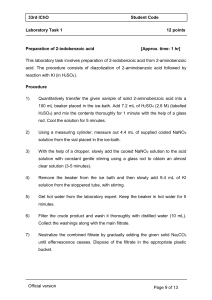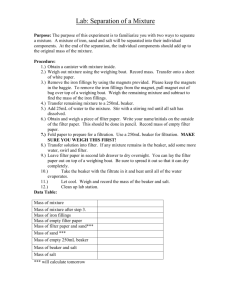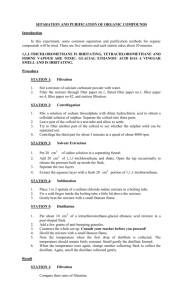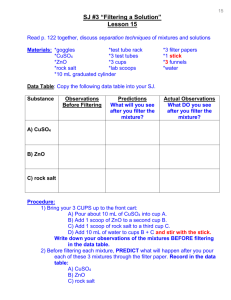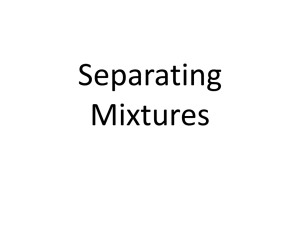Mixture Separation Lab: AP Chem Experiment
advertisement
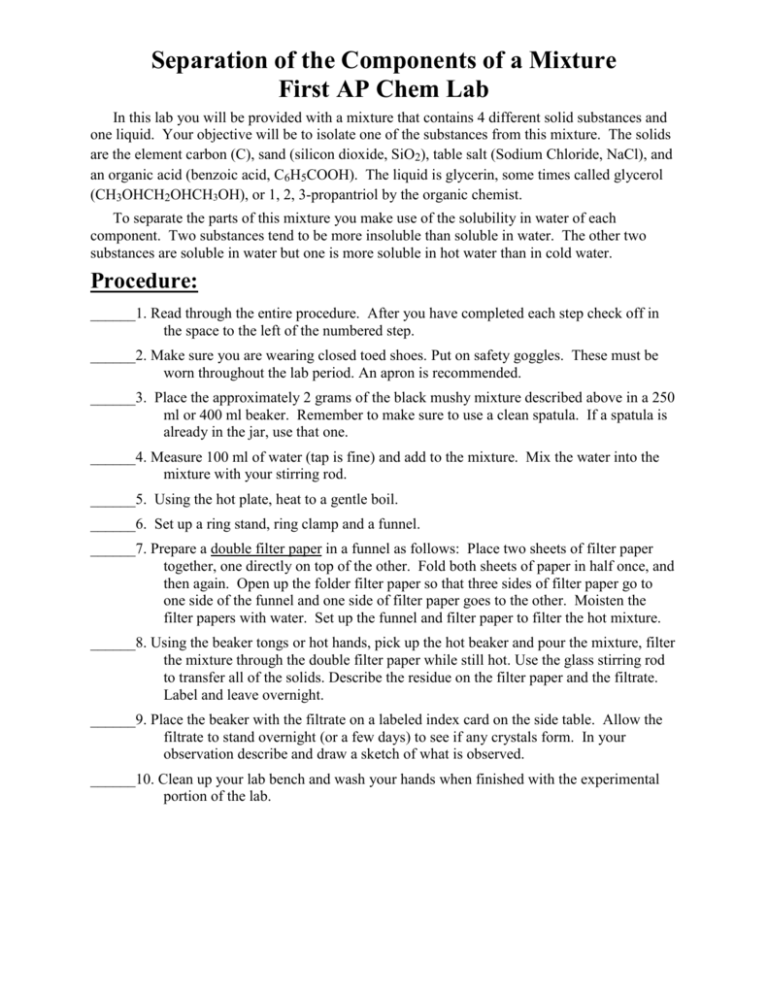
Separation of the Components of a Mixture First AP Chem Lab In this lab you will be provided with a mixture that contains 4 different solid substances and one liquid. Your objective will be to isolate one of the substances from this mixture. The solids are the element carbon (C), sand (silicon dioxide, SiO2), table salt (Sodium Chloride, NaCl), and an organic acid (benzoic acid, C6H5COOH). The liquid is glycerin, some times called glycerol (CH3OHCH2OHCH3OH), or 1, 2, 3-propantriol by the organic chemist. To separate the parts of this mixture you make use of the solubility in water of each component. Two substances tend to be more insoluble than soluble in water. The other two substances are soluble in water but one is more soluble in hot water than in cold water. Procedure: ______1. Read through the entire procedure. After you have completed each step check off in the space to the left of the numbered step. ______2. Make sure you are wearing closed toed shoes. Put on safety goggles. These must be worn throughout the lab period. An apron is recommended. ______3. Place the approximately 2 grams of the black mushy mixture described above in a 250 ml or 400 ml beaker. Remember to make sure to use a clean spatula. If a spatula is already in the jar, use that one. ______4. Measure 100 ml of water (tap is fine) and add to the mixture. Mix the water into the mixture with your stirring rod. ______5. Using the hot plate, heat to a gentle boil. ______6. Set up a ring stand, ring clamp and a funnel. ______7. Prepare a double filter paper in a funnel as follows: Place two sheets of filter paper together, one directly on top of the other. Fold both sheets of paper in half once, and then again. Open up the folder filter paper so that three sides of filter paper go to one side of the funnel and one side of filter paper goes to the other. Moisten the filter papers with water. Set up the funnel and filter paper to filter the hot mixture. ______8. Using the beaker tongs or hot hands, pick up the hot beaker and pour the mixture, filter the mixture through the double filter paper while still hot. Use the glass stirring rod to transfer all of the solids. Describe the residue on the filter paper and the filtrate. Label and leave overnight. ______9. Place the beaker with the filtrate on a labeled index card on the side table. Allow the filtrate to stand overnight (or a few days) to see if any crystals form. In your observation describe and draw a sketch of what is observed. ______10. Clean up your lab bench and wash your hands when finished with the experimental portion of the lab. Data and Observations: 1. Make observations on: a) Initial mixture: b) Residue on the filter paper ( day 1 and day 2): c) Filtrate: 2. Sketch the material in the beaker after the filtrate has sat over night: Conclusion: 1. Which solid(s) were always soluble in water? 2. Which solid(s) were more soluble in hot water than cold water? 3. Which solid(s) were always insoluble in water? 4. Where did the sodium chloride (salt) end up in this procedure? 5. What two types of separation techniques were used in this lab? 6. Draw a flowchart to reflect the separation of the mixture.
